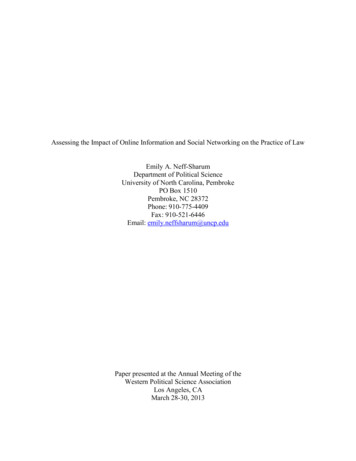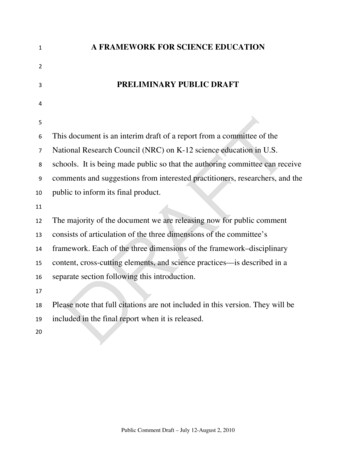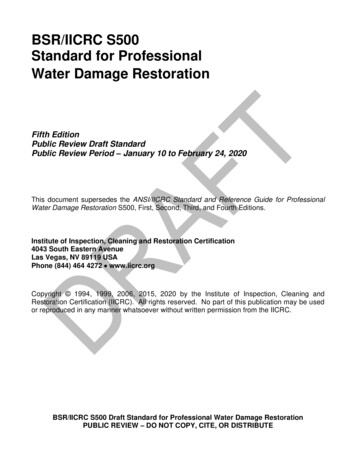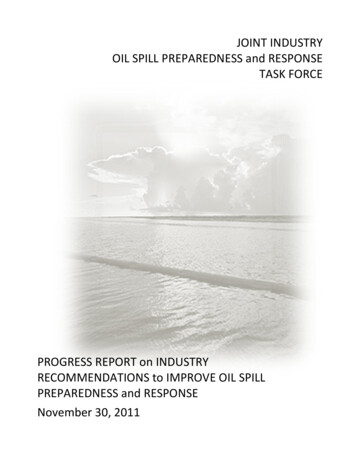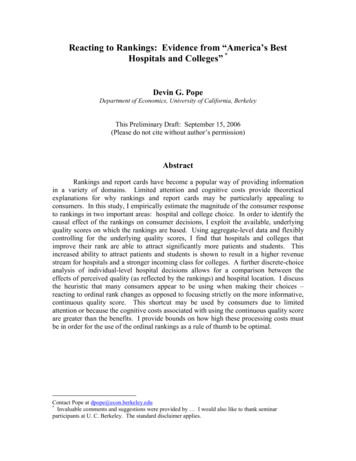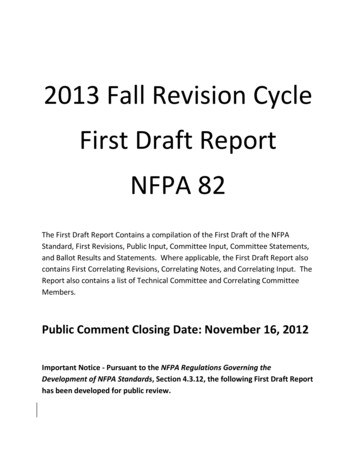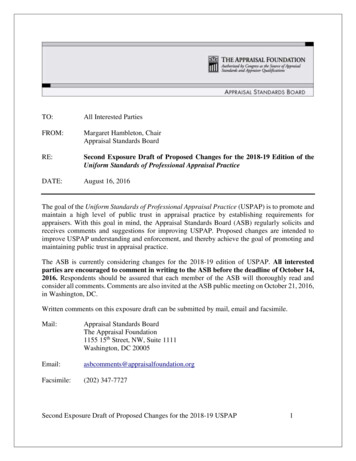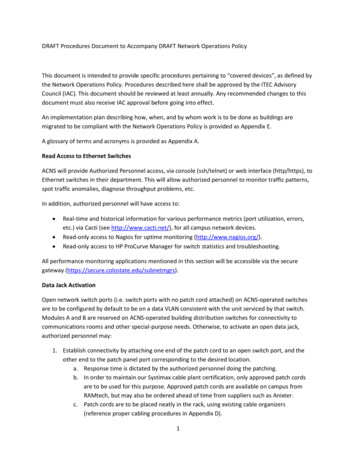
Transcription
PRELIMINARY DRAFT—DO NOT CITE OR QUOTEI.INTRODUCTIONThis report presents an analysis of the feasibility and cost effectiveness ofcold-ironing ocean-going vessels while docked at California ports. Cold-ironingrefers to shutting down auxiliary engines on ships while in port and connecting toelectrical power supplied at the dock, thus eliminating virtually all emissions froma ship while it is in port. (Cold-ironing is also referred to as “shore power” andalternative maritime power). The term “cold-ironing” comes from the act ofdry-docking a vessel, which involves shutting down all on-board combustion,resulting in the vessel going “cold.” Without cold-ironing, auxiliary engines runcontinuously while a ship is docked, or “hotelled,” at a berth to power lighting,ventilation, pumps, communication, and other onboard equipment. Ships canhotel for several hours or several days.Hotelling emissions from ship auxiliary engines are significant contributors toparticulate matter from diesel-fueled engines (diesel PM), California’s mostsignificant toxic air contaminant. Diesel PM emissions are estimated to beresponsible for about 70 percent of the total ambient air toxics risk in California.Communities adjacent to the ports are exposed to elevated cancer risk and otherhealth impacts from these hotelling emissions. As indicated in a recent AirResources Board (ARB or Board) risk analysis conducted for the ports of LosAngeles and Long Beach, “Diesel Particulate Matter Exposure AssessmentStudy for the Ports of Los Angeles and Long Beach,” 20 percent of total dieselPM emissions at these ports comes from hotelling emissions. Other sources ofdiesel PM include emissions from ship transit and maneuvering, cargo-handlingequipment, and rail and truck operations. The analysis concluded that hotellingemissions contribute 34 percent of the total diesel PM population-weighted healthrisks posed to the residents in the surrounding communities. In fact, of all thesources of diesel PM at the ports, hotelling emissions resulted in the largest area(2,036 acres) where the potential cancer risk levels were greater than 200 in amillion in the nearby communities.In addition to local health risks, hotelling emissions of oxides of nitrogen (NOx)also contribute to regional ozone and fine particulate matter (PM2.5) levels.Repeated exposure to ozone can make people more susceptible to respiratoryinfection and lung inflammation and can aggravate preexisting respiratorydiseases, such as asthma. Exposure to fine particulate matter, including dieselPM, can also be linked to premature death and a number of heart and lungdiseases.A.Purpose of StudyThe ARB, port operators, and the local air districts have identified severalstrategies to reduce health impacts posed by hotelling emissions at Californiaports. The analysis presented in this cold-ironing report will provide informationthat can be used for further consideration of these strategies.3/6/2006I-1
PRELIMINARY DRAFT—DO NOT CITE OR QUOTESouth Coast SIPThe 2003 revisions to the State Implementation Plan (SIP) for the South CoastAir Basin required the ARB to evaluate the options for requiring cold-ironing ofships that frequently visit South Coast ports. The SIP is sent to the United StatesEnvironmental Protection Agency (U.S. EPA), as required by the Federal CleanAir Act, and outlines how the State will reduce emissions for regions not meetingfederal ambient air quality standards. The cold-ironing cost-effectivenessanalysis discussed in this report fulfills this specific SIP requirement.Goods MovementThe ARB recently released a draft Emission Reduction Plan for the Ports andInternational Goods Movement in California (December 1, 2005). The planidentifies strategies for reducing emissions created from the movement of goodsthrough California ports and into other regions of the State. The draft EmissionReduction Plan is part of the broader Goods Movement Action Plan being jointlycarried out by the California Environmental Protection Agency and the Business,Transportation, and Housing Agency. Phase I of the Goods Movement ActionPlan was released in September 2005 and highlighted the air pollution impacts ofgoods movement and the urgent need to mitigate localized health risk in affectedcommunities.The draft Emission Reduction Plan identifies numerous strategies for reducingemissions from all significant emission sources involved in the goods movement,including ocean-going vessels, harbor craft, cargo handling equipment,locomotives, and trucks. The draft Plan identifies several strategies for reducingemissions from ocean-going vessels, including cold-ironing ships when in port.The analysis discussed in this cold-ironing report will provide information neededfor further consideration of the cold-ironing strategies identified in the draftEmission Reduction Report. Staff anticipates refining the draft EmissionReduction Plan over the next several months, based on public comments andtechnical input.Diesel Risk Reduction PlanThe Board has committed to reducing statewide risk posed by diesel PM in itsDiesel Risk Reduction Plan. The ARB released the Diesel Risk Reduction Planin 2000 and established a goal of 85 percent reduction in diesel PM in Californiaby 2020. Because hotelling emissions are significant sources of diesel PM,controlling emissions from this source category could play a significant role inmeeting the 85 percent diesel PM emission reduction goal. The information inthe cold-ironing analysis presented in this report could help determine if coldironing is a cost-effective measure for controlling diesel PM emissions fromauxiliary engines on ocean-going vessels while in port.3/6/2006I-2
PRELIMINARY DRAFT—DO NOT CITE OR QUOTEB.Significance of Ports and their Emissions in CaliforniaPorts play a critical role in California's economy. California's location provides ageographic advantage for trade with China and other countries in Asia. In 2003,73 percent of U.S. imports from Asia entered through California ports, and tradewith Asia is expected to significantly increase. Since 2000, container traffic hasincreased by 40 percent at the ports of Los Angeles and Long Beach and, by2020, cargo movement at California's ports is expected to triple from 2005 levels.California is home to three of the largest ports in the nation. The San Pedro Bayports of Los Angeles and Long Beach comprise the largest container portcomplex in the nation and the third largest in the world. The Port of Oakland isthe seventh largest container port in the nation. The cargo moving through theSan Pedro Bay ports is valued at over 200 billion per year. Fifty to sixty percentof the goods passing through these ports are destined for other parts of theregion and the country, making the ports a global gateway for the country’s trade.Port emissions contribute to regional air pollution and impact a region’s ability tomeet attainment of health-protective air quality standards. The ports are alsosignificant contributors to local diesel PM emissions. Port air emissions comefrom ocean-going vessel activities, harbor-craft activities, cargo-handlingequipment, and locomotives and trucks used to move the cargo through theterminals and port property. Most of the engines used in these activities arediesel-fueled.In 1998, the Board identified particulate matter from diesel-fueled engines(diesel PM) as a toxic air contaminant because of its potential to cause cancerand other health problems, including aggravation of respiratory andcardiovascular diseases. The greatest health impacts from exposure to dieselPM from ports occur in the communities adjacent to the ports—in many caseslow-income or minority communities—making port emissions an environmentaljustice concern.C.Scope of the Cold-Ironing Evaluation ReportAs stated earlier, the purpose of this report is to determine the cost effectivenessof cold-ironing ocean-going vessels that visit California ports. There arealternative techniques for reducing emissions from onboard auxiliary engineswhile hotelling. These include switching to cleaner fuels, using selective catalyticreduction, and installing particulate control devices. These are mentioned brieflyin Chapter XII. It was not staff’s intent to discuss these alternatives in detail, butto merely acknowledge them. Staff’s goal was to determine under whatcircumstances cold-ironing would be cost-effective as a potential air pollutionmitigation measure.3/6/2006I-3
PRELIMINARY DRAFT—DO NOT CITE OR QUOTEThe actual infrastructure requirements and costs associated with cold-ironing aresite-specific. Where possible, staff has taken into account information at specificports. Nevertheless, a considerable amount of engineering is required to fullydesign a cold-ironing project at a port. This level of detail is beyond the scope ofthis report. Other issues, such as legal jurisdictions, port tenant leases, andworker safety are also beyond the scope of this report.The results of this cost-effectiveness analysis provide a framework for furtherconsideration of cold-ironing at California ports—what ships and ports are bestsuited for this technique for reducing air pollutants and protecting public health.D.Outreach Efforts during Development of the ReportThe ARB staff is currently soliciting public comments on this draft report.During the development of this report, staff undertook several outreach measuresto gather information and receive public input. ARB’s plan for analyzing the costeffectiveness of cold-ironing ocean-going vessels was first discussed at a publicconsultation meeting on November 9, 2004. Preliminary concepts for theanalysis were discussed at the May 14, 2005, Maritime Workgroup meeting. Thisworkgroup is comprised of ARB staff, local air district staff, representatives of theports, shipping companies and environmental groups, and other interestedmembers of the public.During the report’s development, staff visited four ports in California: LosAngeles, Long Beach, Oakland, and San Diego. Staff also visited threecold-ironing applications in the State: a ship utilizing shore power at theUSS POSCO steel plant in Pittsburg, a ship utilizing shore power at the ChinaShipping Terminal at the Port of Los Angeles, and a Navy ship cold-ironing at theNaval Station in San Diego. During these visits, staff observed the configurationof the ports, terminals, and berths and gained an understanding of the logisticsinvolved in bringing power to the terminals and individual berths.Staff also held conference calls and/or met with shipping companies, utilitycompanies, environmental groups, and other organizations interested incold-ironing applications. These meetings gave staff the opportunity to hear fromproponents of cold-ironing as well as hear the concerns from those entities thatwould be involved with bringing power to the terminals and retrofitting ships forcold-ironing. Staff also held conference calls with SCAQMD staff to obtain theirinput during the development of the report.E.Future EffortsAs mentioned earlier, a commitment in the 2003 South Coast SIP revisions led tothe development of this report. ARB staff worked with South Coast AQMD staffto evaluate cold-ironing as a potential pollution-reduction strategy at the ports ofLos Angeles and Long Beach. The SIP commitment further stated that, if3/6/2006I-4
PRELIMINARY DRAFT—DO NOT CITE OR QUOTEcold-ironing was determined to be cost-effective, staff would develop a regulationto include cold-ironing as a pollution-reduction measure for the South Coastports.No measures are currently in place requiring cold-ironing. However, cold-ironinghas been identified as a strategy for reducing ocean-going vessel emissions inARB’s draft Emission Reduction Plan, which was developed as part of the GoodMovement Action Plan. Of all the emission sources involved with the GoodsMovement in California, ship emissions are the least controlled. As wasmentioned early, activity at the ports is expected to triple by 2020, leading tosignificant emission increases from ship activities if left uncontrolled.Consequently, cold-ironing may become an effective control measure forsignificantly reducing hotelling emissions in the future.3/6/2006I-5
PRELIMINARY DRAFT—DO NOT CITE OR QUOTEII.GENERAL DESCRIPTION OF SHIP CATEGORIES AND CALIFORNIAPORTSThis chapter provides a description of the types of ocean-going vessels that visitCalifornia ports. It also provides a general description of the major ports inCalifornia.A.Ship Category DescriptionsOcean-going vessels are designed to carry specific types of cargo or material.For example, ships transporting automobiles are designed differently than shipscarrying perishable food products. The type of cargo entering or leaving a portwill determine which types of ships visit that port. There are six generalcategories of ships that are briefly described below: container, passenger,reefer, tanker, bulk, and vehicle carrier.Container Ships: Container ships are designed to transport cargo, such asfurniture, electronics, and clothes, in standardized containers. These containershave capacities measured in TEUs (twenty-foot equivalent units). Thedimensions of a TEU are 20’ X 8’ X 8.5’ and a typical container is 40 feet long ortwo TEUs.Passenger Ships: Passenger ships carry passengers on pleasure voyages.These ships typically stop at ports to allow passengers to participate incoordinated activities on shore. These ships also include swimming pools,restaurants, and fitness centers for on-board recreation.Reefer Ships: Reefer ships are used to transport perishable products, such asfruit and meat. These products are usually palletized and stored in largerefrigerated cargo holds.Tankers: Tankers are designed to carry liquid and gaseous products, such ascrude oil, finished petroleum products, and chemicals. These products arepumped into and out of the vessels when in port.Bulk Ships: Bulk and general cargo ships carry material that is not easily placeinto containers, such as wood chips, grains, gypsum, and rolls of steel. Thecargo is usually shipped in large quantities and does not need to be in packagedform.Vehicle Carriers: These ships carry wheeled cargo, such as automobiles,trailers, or railway carriages. These ships are also referred to as “RORO’s”because the cargo can be rolled on and off the vessels when in port.3/6/2006II - 1
PRELIMINARY DRAFT—DO NOT CITE OR QUOTEB.California PortsEach of the California ports is unique not only in its physical size but also in thetypes and amounts of cargo that is handled at the port. Each port can have oneto several terminals. Each terminal can have one to several berths. Eachterminal is usually dedicated to a certain type of ship, such as a container ship orpassenger ship. The Ports of Los Angeles and Long Beach make up the largestport complex in the State. The majority of ship calls in California are made tothese two ports. Table II-1 shows the number of ship visits by port based on2004 data. The Port of Oakland has the third most ship visits in the State. Allother ports account for 26 percent of remaining California ship visits.Table II-1: Port Ranking by Ship VisitsPortLos Angeles/Long BeachOaklandRichmondSan DiegoSan FranciscoCarquinezHuenemeEl SegundoStocktonAll OtherTotalNumber of entage of TotalVisits to State55%19%5%5%4%4%3%2%1%2%100%Table II-2 shows the number of terminals and berths by ship category at eachport.3/6/2006II - 2
PRELIMINARY DRAFT—DO NOT CITE OR QUOTETable II-2: Number of Terminals and Berths per Ship Category for Each California nkerBTB12PassengerTBTotalTB361112no 1El Segundo1Hueneme1111HumboldtLong Beach/ Los 0no wharfMontereyOakland2819bulk ships at port already cold-ironedPittsburgRedwood City35Richmond12Sacramento6611San Francisco2412Stockton9141145742229San cording to the State Lands Commission, 2004 data for Benicia was subsumed into other ports’ data.As can be seen in Table II-2, there are 108 terminals at California ports providingservices to nearly 200 berths. Some terminals receive ships from more than onecategory. For example, at Richmond, vehicle carrier ships and bulk cargo shipsvisit the same berths. For these cases, staff assigned the terminals and berths tothe type of ships that utilizes them the most. The Port of Los Angeles and thePort of Long Beach combined (POLA/POLB) handle ships from all categories3/6/2006II - 3
PRELIMINARY DRAFT—DO NOT CITE OR QUOTEand have the greatest number of terminals and berths, 56 and 114, respectively.It should be noted that there are other terminals and berths at these ports butthey are used primarily for such activities as cargo storage and port services ormay not currently be in use. There are very specialized ports, with El Segundoreceiving only tankers, and Crockett, Humboldt, Redwood City, Stockton, andSacramento receiving predominately bulk deliveries. The Ports of AvalonCatalina and Monterey do not have terminals because they have no wharfs.Passenger ships at these ports anchor offshore, and smaller boats ferrypassengers to and from shore. There is only one facility using the port atPittsburg, USS POSCO, and all four bulk ships that deliver to this facility arecold-ironed.From a ship perspective, container ships visit three ports: Long Beach, LosAngeles, and Oakland. Reefers also visit only three ports: Hueneme, LosAngeles, and San Diego. Vehicle carriers visit six ports: Carquinez, Hueneme,Long Beach, Los Angeles, Richmond, and San Diego. Passenger ships visit sixports: Hueneme, Humboldt, Long Beach, Los Angeles, San Diego, and SanFrancisco. Tankers visit Carquinez, El Segundo, Long Beach, Los Angeles,Richmond, San Francisco, and Stockton. Bulk ships visit nearly all of the ports.In 2004, there were just over 1,900 ships making a total of just over 9,600 visitsto California ports. Table II-3 summarizes these ship visits by ship category.For comparison purposes, ship visits are presented for all ships visitingCalifornia, ships making three or more visits to one California port, and shipsmaking six or more visits to one California port.Table II-3: Ship Visits to California Ports in 2004, by Ship cleCarrierBulkTotal3/6/2006Total ShipsVisitingCaliforniaTotalShipVisitsNumber ofShipsMaking 3or MoreVisits to 2II - 4Total Visitsfrom ShipsMaking 3or MoreVisits to aCaliforniaPortNumber ofShipsMaking 6or MoreVisits to aCaliforniaPortTotal Visitsfrom ShipsMaking 6 orMore Visitsto aCaliforniaPort
PRELIMINARY DRAFT—DO NOT CITE OR QUOTEOverall, 39 percent of ships visiting California in 2004 made three or more visitsto one port (747 of 1,906) and 19 percent made six or more visits to one port(369 of 1,906). While container ships comprise less than a third of the total shipsvisiting in 2004 (592 of 1,906), they made nearly 50 percent of the total ship visits(4,727 of 9,613). Container ships dominate in the category of ships visiting aspecific port often (six or more times), accounting for 72 percent of these ships(247 of 344). Furthermore, container ships visiting a port six or more times makeabout 70 percent of the total container ship visits (3,297 of 4,727). Reefers andpassenger ships made the least ship visits in 2004. However, about 85 percentof passenger ships’ total visits and 70 percent of reefer ships’ total visits weremade by ships visiting a port six or more times.3/6/2006II - 5
PRELIMINARY DRAFT—DO NOT CITE OR QUOTEIII.CURRENT EMISSION REDUCTION AND COLD-IRONING ACTIVITIESAT PORTS ON THE WEST COASTThis chapter discusses emission reduction efforts currently underway atCalifornia ports. Some of these efforts include conducting cold-ironing studiesand implementing cold-ironing measures. This chapter also discusses coldironing applications already operating or planned at ports on the West Coast.Finally, this chapter discusses the challenges involved with adding shore-powerinstallations to ports in California.A.Current Emission Reduction Efforts at California PortsPort of Los AngelesIn 2001, then Los Angeles Mayor James Hahn initiated a “No Net Increase” (NNI)policy for the Port of Los Angeles. The purpose of this policy was to roll backand maintain air emissions from the Port’s activities to October 2001 levels. ATask Force was established to develop a plan to meet the NNI policy goals. TheTask Force met in 2004-2005, and in June 2005, delivered a report identifying68 control measures for various port-retailed activities that could reduce andcontrol emissions through 2025. In November 2005, Port staff released a draftreport, “NNI Control Measures Evaluation Overview,” as directed by the LosAngeles Board of Harbor Commissioners. The NNI strategy has not yet beenadopted.One of the NNI control measures recommended for implementation, NNIMeasure Number OGV16, is the expansion of a program already underway atthe Port, referred to as the Alternative Maritime Power (AMP) program. ThePort’s current AMP program is a voluntary program intended to reduce hotellingemissions from ships by providing shore power to container and passengerships. Under this program, a shipping company agrees to utilize shore power atthe Port for at least five years as part of its lease agreement. As an incentive forthis program, the Port will provide up to 810,000 to defray the cost of addingshore-power equipment to one ship. NNI Measure Number OGV16 would gobeyond these voluntary measures and require all passenger ships and all otherships calling at the port five or more times a year to be cold-ironed. It would alsorequire all terminals to utilize shore power on 70 percent of the ship calls withintwo years of entering a new lease or renewing an existing lease with the Port.Port of Long BeachIn April 2003, the Port of Long Beach commissioned ENVIRON International toconduct a study on the feasibility of connecting ships to electricity rather thanrunning their auxiliary engines while docked at the Port. The study, “Cold IroningCost Effectiveness Study,” was released in March 2004, and it evaluated3/6/2006III - 1
PRELIMINARY DRAFT—DO NOT CITE OR QUOTE12 vessels chosen to represent a cross-section of vessel types, vessel ages, andport calls. Hotelling emissions were calculated based on the hours the ship wasin dock, the ship's power requirements at berth, the number of calls per year, andthe pollutant emission factors for the auxiliary engines. The study includedestimated costs for adding shore-side power to each berth where the 12 vesselsdocked. Estimated costs were also included for retrofitting the 12 vessels to runon shore power. Fuel cost savings estimates were based on two ships usingdistillate oil and ten ships using residual oil.Using a cost-effectiveness threshold of 15,000 per ton of total emissionsreduced (NOx, SOx, CO, VOC, and PM—all equally weighed) and a project lifeof 10 years, the analysis indicated that five out of the 12 vessels studied wouldbe potential candidates for cold-ironing. These vessels included one containership, two reefers (ships with refrigerated holds), a passenger ship, and a tanker.These five ships had higher hotelling power requirements, longer berth times,and more frequent berth calls than the other ships in the study.The study indicated that the cost effectiveness of cold-ironing could also bedetermined by the annual power consumption of a vessel at a specific berth. Fora retrofit scenario, where the ship is retrofitted for shore power after it is built andthe berth is retrofitted with a shore power infrastructure after it is constructed, thecost-effectiveness threshold appears to correlate with 1.8 million kilowatt-hour(kW-hr) or more of annual power consumption at the berth. For the scenariowhere shore power is installed during the construction of a berth and the vesselis equipped with shore power capabilities when it is built, the cost-effectivenessthreshold is at 1.5 million kW-hr or more of annual power consumption at theberth.ENVIRON performed a follow-up study in November 2004 to determine which ofthe frequent callers at the Port (those ships with more than six visits per year)were likely candidates for cold-ironing. Out of 151 frequent callers, 26 shipswere identified as being potential candidates. These ships included 22 containerships, two reefers, and two passenger ships.In January 2005, the Long Beach Board of Harbor Commissioners approved aGreen Port Policy which is intended to guide the Port’s operations in a “green”manner. The Port has committed to providing shore-side power at new andreconstructed container terminal berths and other berths as appropriate.Through lease language, the Port will require selected vessels to use shorepower and all other vessels to use low-sulfur diesel in their auxiliary generators.According to the Third Quarterly Report for the Green Port Program, datedDecember 13, 2005, cold-ironing projects are being developed at three berths atthe Port—one of them a voluntary project with the tenant.3/6/2006III - 2
PRELIMINARY DRAFT—DO NOT CITE OR QUOTEPort of OaklandThe Port has an Air Quality Mitigation Program that targets emission reductionsfrom trucks, local buses, tugboats, and container-terminal equipment. In additionto these activities, the Port has indicated that it is planning on evaluating thefeasibility of adding shore power to its terminals in the future.Port of San FranciscoIn October 2004, the Port of San Francisco commissioned ENVIRON to conducta study on the feasibility of providing shore power at the new passenger shipterminal at Piers 30-32. The new terminal is scheduled for completion in 2008.The feasibility study was required as part of the permit conditions set by the SanFrancisco Bay Conservation and Development Commission. In this study, fourpassenger ships that currently visit the Port were evaluated for potential coldironing candidates. One of these ships, the Dawn Princess, is already coldironed when at port in Juneau, Alaska. The cost estimates used in the reportincluded high- and low-end estimates for ship-side conversions and shore-sideinfrastructure capital costs. Ship conversion costs ranged from 500,000 to 700,000, and shore-side infrastructure costs ranged from 1.4 million to 2.8 million, depending on the possible routes for bringing electrical power to theproperty line. The project life was assumed to be 20 years. Energy cost had asignificant impact on the cost of the project. Energy costs were estimated at 0.22/kW-hr if only one ship was cold-ironed but dropped significantly to 0.14/kW-hr if all four vessels were cold-ironed.The hotelling emission reductions used in the cost-effectiveness determinationincluded only tons of NOx reduced plus 10 times the tons of PM reduced (aftersubtracting power plants emissions). The report considered the costeffectiveness threshold for tons of NOx plus 10 times PM reduced as beingapproximately 14,000, which represented ARB’s Carl Moyer Programrequirements at the time the report was developed. The cost effectiveness wasdetermined for four scenarios: one ship cold-ironed; two ships cold-ironed; threeships cold-ironed; and four ships cold-ironed at berths 30-32. As expected, theproject became more cost effective as more ships were assumed to cold-ironwhile hotelling. The analysis indicated that the cost effectiveness would be in therange of 5,500 to 7,000 per combined tons of NOx and PM reduced if all fourships analyzed in the study were cold-ironed when docked at the terminal.After determining that shore power usage at the new passenger ship terminalwould be technically feasible, the port will now evaluate the actualimplementation of a shore power project. This will include developing morespecific cost estimates for designing and building the shore power infrastructureat the terminal, obtaining more definitive cost estimates for power from theelectricity providers, and evaluating possible incentives for cruise lines to utilizeshore power at the new terminal.3/6/2006III - 3
PRELIMINARY DRAFT—DO NOT CITE OR QUOTEPort of San DiegoThe Port of San Diego is developing a conceptual design for including shorepower at its B-Street Pier passenger ship terminal, which the Port plans toredevelop. This Pier is the home port for passenger ships that begin their cruisesin San Diego.B.Current Cold-Ironing Applications on the West CoastThe following are descriptions of cold-ironing installations already operating onthe West Coast.China Shipping Terminal at Port of Los AngelesThe Port of Los Angeles retrofitted the China Shipping Terminal to include ashore-power infrastructure as part of a lawsuit settlement with the NaturalResources Defense Council (NRDC), the Coalition for Clean Air, and localcommunity groups. The settlement requires a minimum of 70 percent of shipcalls to this berth, on an annual average, to utilize shore power. Two shipsbegan connecting to shore power in June 2004. According to the Port’sStipulated Judgment Quarterly Report for the third quarter of 2005, there are now15 China Shipping vessels that are equipped with shore power. During the firstthree quarters of 2005, shore power was used for 28 out of 39 ship calls to Berth100, or an average shore power use of 72 percent. Although an impressive start,these 28 cold-ironed ship calls still represent a small fraction of overall containership visits to the Port. In 2004, the Port had 2,940 container ship visits.At this site, a substation at the edge of the property supplies 14.5 kilovolts (kV) ofelectricity, which is stepped down by a nearby transformer to 6.6 kV.Underground cab
Shipping Terminal at the Port of Los Angeles, and a Navy ship cold-ironing at the Naval Station in San Diego. During these visits, staff observed the configuration of the ports, terminals, and berths and gained an understanding of the logistics involved in bringing power to the terminals and individual berths.
